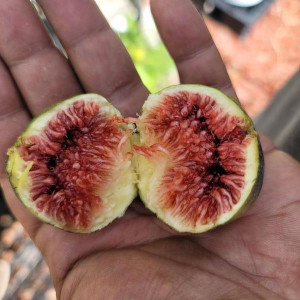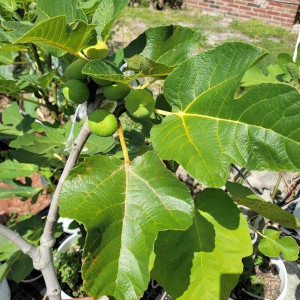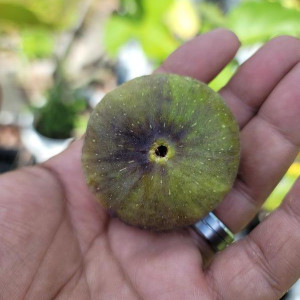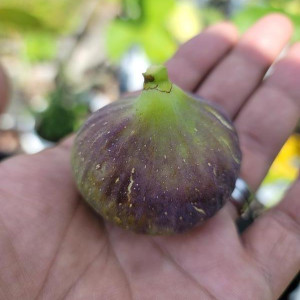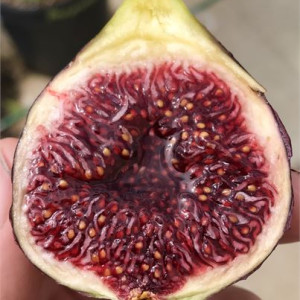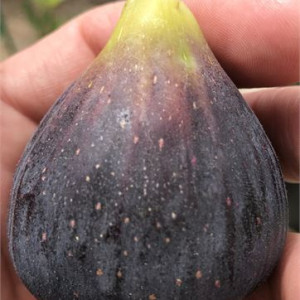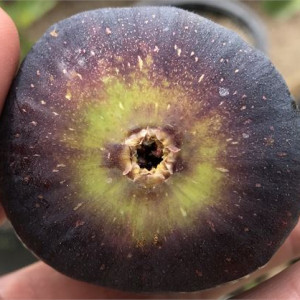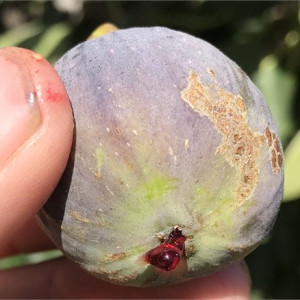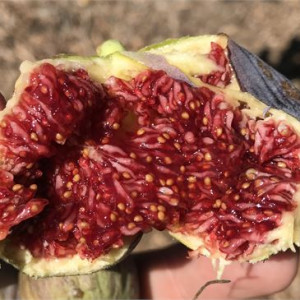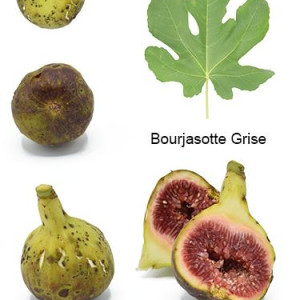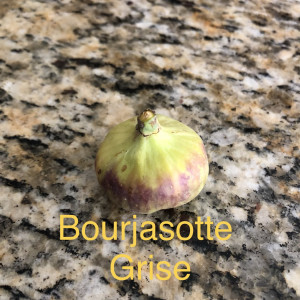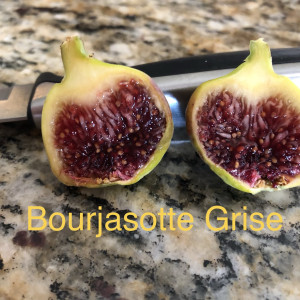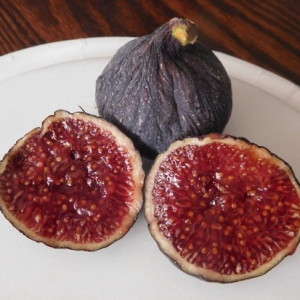This site contains affiliate links for which I may be compensated.
Bourjassotte Grise
Bourjassotte Grise Information
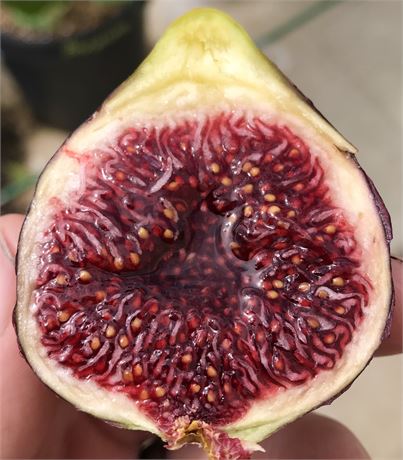

-
Possible Synonyms / AKA:
DFIC 190, Bourjasotte Grise
Resubmitted under DFIC 339 as Bourjassotte Grise.
Grizzly Bourjassotte, Negro Largo (DFIC 228), and Violet Sepor (DFIC 210)
According to Condit, also named as an old variety by the name of Blanche. -
Introduced By:
-
Origin:
Spain -
Main Flavor Group:
Dark Berry - From mildly to very sweet, with distinct berry notes complemented by a touch of acidity. They often feature subtle complexity, with additional layers of flavor that enhance their rich and balanced profile. -
Family Group:
-
Fig Type:
Common - Self fertile and will grow anywhere conditions are suitable -
Cold Hardy:
N/A -
Container Variety:
Yes -
Easy Rooting:
N/A -
Main Season:
mid -
Availability:
Average -
Breba Crop:
Yes -
Seed Crunch:
mild -
Eye:
small -
Skin Toughness:
moderate -
Fruit Size:
Medium to large -
Rain Resistance:
Low -
Tree Vigor:
N/A -
External Links:
http://seattlegardenfruit.blogspot.com/2018/10/tasting-bourjasotte-grise-fig-2018.html
https://www.ourfigs.com/forum/figs-home/594955-prusch-park-bourjasotte-grise-vs-socorro-black-please-share-your-experiences
https://www.ourfigs.com/forum/figs-home/364335-bourjasotte-grise-main-2018
https://www.ourfigs.com/forum/figs-home/362224-bourjasotte-grise
https://www.ourfigs.com/forum/figs-home/389439-bourjasotte-grise
https://www.ourfigs.com/forum/figs-home/316475-bourjasotte-grise-breba
https://www.ourfigs.com/forum/figs-home/345408-bourjasotte-grise-and-violet-sepor-are-they-the-same?p=345620#post345620
Description
Originally submitted as GRIN .gov/gringlobal/accessiondetail.aspx?id=1687997"> DFIC 190, as Bourjassote Grise, but did not establish. Resubmitted under DFIC 339 as Bourjassotte Grise. See GRIN .gov/cgi-bin/ NPGS /acc/display.pl?1576137"> DFIC PI 18847
The following applies specifically to Bourjassotte Grise ( DFIC 190), but may apply to DFIC 339 since it was a re-submission:
Based upon genetic testing performed in 2010, GRIN .gov/gringlobal/accessiondetail?id=1687997">Bourjassotte Grise ( DFIC 190), Negro Largo ( DFIC 228), and Violet Sepor ( DFIC 210) were determined to be synonyms. See Genetic structure and differentiation in cultivated fig (Ficus carica L.). Large fruits – pale green with purplish flush. Flesh dense red. Rich syrupy juice with excellent flavor. Profuse cropper. Very similar to Black ">Socorro Black .
The following applies specifically to Bourjassotte Grise ( DFIC 190), but may apply to DFIC 339 since it was a re-submission:
Based upon genetic testing performed in 2010, GRIN .gov/gringlobal/accessiondetail?id=1687997">Bourjassotte Grise ( DFIC 190), Negro Largo ( DFIC 228), and Violet Sepor ( DFIC 210) were determined to be synonyms. See Genetic structure and differentiation in cultivated fig (Ficus carica L.). Large fruits – pale green with purplish flush. Flesh dense red. Rich syrupy juice with excellent flavor. Profuse cropper. Very similar to Black ">Socorro Black .
The English gourmet writer, Edward A. Bunyard, wrote in his classic The Anatomy of Dessert: “Bourjassotte Gris with it’s brown-red almost jelly-like flesh is in the very foremost rank of figdom, and among the somber regiment of purple or Black varieties, Negro Largo, Negronne, Violette DE Bordeaux, will all meet the epicure’s approval.”
Condit Monograph
Bourjassotte Grisé (syn. Grizzly Bourjassotte). Described by Audibert Frères (1854), Hogg (1866), Barron (1868d, 1869a, 1891), Moore (1871), Pearson (1872), Rivers (1873), Luckhurst (1880), Wright (1895), Eisen (1901), Wythes (1902), Bunyard and Thomas (1904), E. A. Bunyard (1925, 1934), O. T. (1905), Starnes and Monroe (1907), Royal Hort. Society (1916), Cook (1925), Arnold (1926), and Preston (1951). Illustrated in color by Wright. Illustrated in Black and white by Moore, O. T., Starnes and Monroe, T. (1907), and Condit (1941a, fig. 2, K).
Pearson stated in 1872 that Bourjassotte Grisé was a new name for an old variety, grown for many years at Clumber, England, under the name Blanche. According to Rivers, the Bourjassotte figs were so named because they came from Burjasot, a village in Spain, near Valencia. Barron (1891) reported Bourjassotte Grisé as “the most constantly good fig” he had grown. It has long been highly regarded in England, especially for forcing.
The variety was introduced into California as P.I. No. 18,847, from the Chiswick collection. Outside of collections, two trees of this variety have been located in California; one is in front of the Court House Annex, Santa Ana; the other is in the garden of Mr. Robert Gallegos, Mission San Jose. At both of these places and at Riverside, the production of brebas is very light, and dropping of green, immature figs of the second crop is heavy; apparently, this is an example of partial or incomplete parthenocarpy.
Tree fairly dense, vigorous; terminal buds violet. Leaves medium, mostly 3-lobed; upper surface glossy; upper sinuses of medium depth and width; base subcordate; margins coarsely crenate. The following description is taken from fruit borne by trees at Riverside, Los Angeles, and Fresno.
Brebas few, many not maturing properly, medium, turbinate, with broad, flattened, or somewhat depressed apex; color greenish bronze, or violet; white flecks conspicuous; pulp dark strawberry; quality fair.
Second-crop figs medium, 1-1/2 to 2 inches in length, and about the same in diameter, pyriform to oblate-turbinate, with short, thick neck; average weight 38 grams; stalk short; ribs slightly elevated, hardly prominent; eye medium, open, scales tinged with violet; white flecks numerous, conspicuous; color greenish violet, darker at the apex, many specimens showing a green zone persisting around the eye and on the sides; pruinose bloom well marked; pulp strawberry; quality fair. (Plates 10; 11; 12; 25, B.)
Caprified specimens with external color violet-brown; pulp blood red; flavor subacid, rather strong.
If you'd like your banner to be shown here and throughout Fig Database, send us a message.











